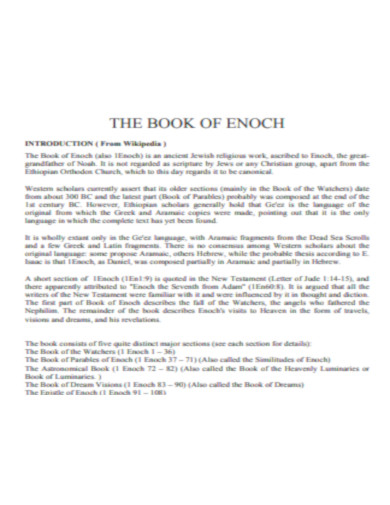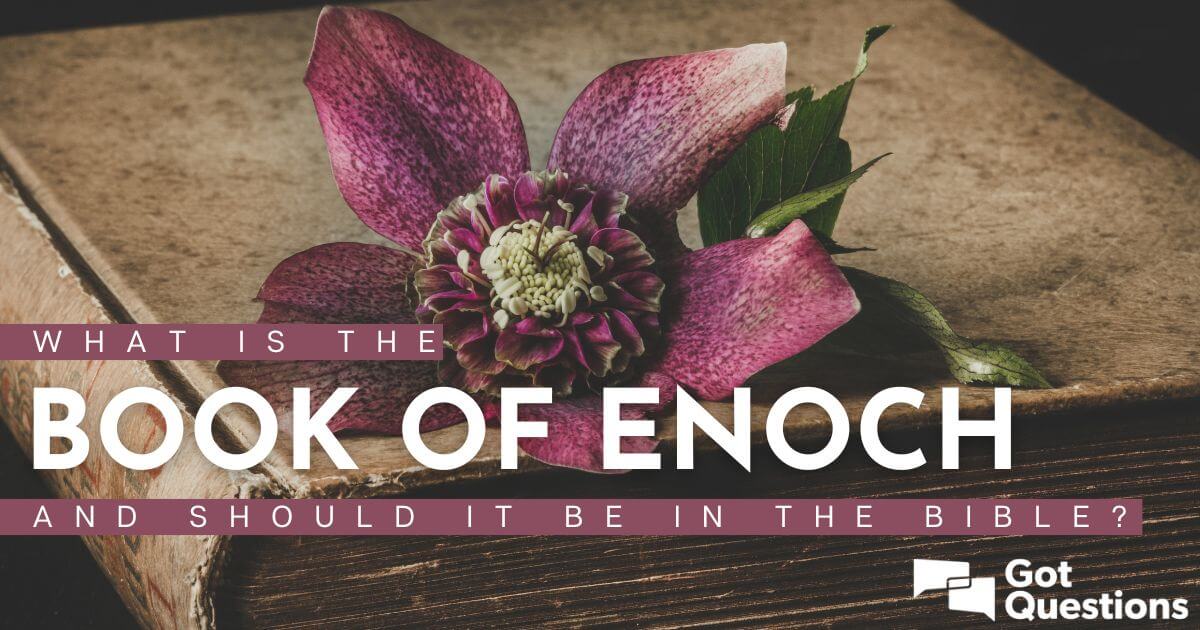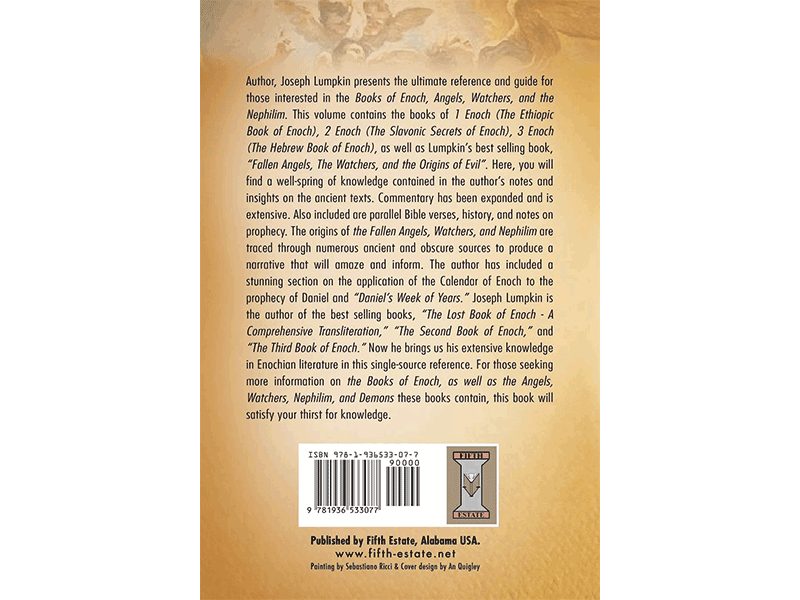The Book of Enoch is an ancient religious text that has captivated scholars and spiritual seekers alike for centuries. It is a non-canonical apocryphal text, meaning it is not included in the Hebrew Bible or Christian New Testament. However, it holds significant importance in various religious traditions, including Second Temple Judaism, early Christianity, and Ethiopian Christianity. The Book of Enoch offers a unique insight into the beliefs and practices of these ancient faiths, providing a bridge between different cultural and religious perspectives.
Seemore: Why Stay Away from the Book of Enoch
The Origins and Purpose of the Book of Enoch

The Book of Enoch is attributed to Enoch, a figure mentioned in the biblical narrative of the Genesis flood. According to the book, Enoch is taken on a journey through the heavens by angels, where he receives divine revelations. He is then instructed to record his visions and teachings for future generations. These writings are believed to have been passed down orally and eventually recorded in the form of the Book of Enoch. However, there is much debate among scholars regarding the exact authorship and timeline of its composition.
Some argue that the book was originally written in Aramaic, the common language of the Near East during the Second Temple period (around the 2nd century BC). Others suggest that it was composed in Hebrew or Greek, and later translated into other languages. In any case, the purpose of the Book of Enoch was to preserve and transmit ancient wisdom and knowledge, as well as to serve as a warning against the corrupting influence of fallen angels.
The Historical Context of the Book of Enoch

To understand the significance of the Book of Enoch, it is essential to examine its historical context. The text was written during the tumultuous period of the Second Temple, when the Jewish people were under foreign rule and faced numerous challenges to their religious traditions and cultural identity. This was also a time of great spiritual and intellectual ferment, with various sects and movements vying for influence and authority.
The Book of Enoch reflects the complex and diverse religious landscape of this era. It contains elements of Jewish, Christian, and pagan beliefs and practices, reflecting the cultural exchange and cross-pollination that characterized this period. In particular, the book draws upon ancient Near Eastern mythology and cosmology, as well as apocalyptic and eschatological traditions.
The Major Themes of the Book of Enoch

The Book of Enoch is a rich and multifaceted text, addressing a wide range of themes and topics. Some of the most prominent themes include the fallen angels, the Watchers, and divine judgment. As we explore these themes in more detail, it is important to note that the Book of Enoch should not be interpreted as a historical or literal account, but rather as a symbolic and metaphorical representation of spiritual truths.
The Fallen Angels
One of the central narratives of the Book of Enoch is the story of the fallen angels, which is described in the first section of the book, known as the Book of the Watchers. According to this account, a group of angels led by Semjaza descended to Earth and intermarried with human women, giving rise to the Nephilim, a race of giants. These fallen angels are depicted as corrupting and deceiving humanity, teaching them forbidden knowledge and leading them astray.
This theme of fallen angels is also found in other ancient texts, such as the Book of Jubilees and the Dead Sea Scrolls. It reflects an underlying concern with the presence of evil and wickedness in the world, and the role of supernatural forces in this struggle between good and evil. The fallen angels are seen as agents of chaos and rebellion, who ultimately bring about their own destruction through their disobedience to God.
The Watchers
The term “Watchers” refers not only to the fallen angels, but also to a group of heavenly beings who are tasked with observing and recording human actions. The Book of Enoch provides a detailed list of these Watchers and their respective roles and responsibilities. They are portrayed as both benevolent and malevolent, depending on their actions and intentions towards humanity.
One of the main functions of the Watchers is to act as intermediaries between God and humans, conveying divine messages and instructions. However, some of the Watchers in the Book of Enoch are also depicted as engaging in forbidden relationships with humans, leading to their fall from grace. This dual nature of the Watchers reflects the belief in the potential for both good and evil in all beings.
Divine Judgment
Another significant theme in the Book of Enoch is divine judgment and the consequences of disobedience. The fallen angels and their offspring, the Nephilim, are ultimately punished for their transgressions against God and humanity. This serves as a warning against the corrupting influence of pride and rebellion, and the importance of remaining faithful to one’s spiritual duties and responsibilities.
The concept of divine judgment is also central to the apocalyptic and eschatological sections of the Book of Enoch, which describe the end times and the final judgment of all beings. This theme is closely related to the idea of reward and punishment based on one’s actions and beliefs, and the belief in an ultimate reckoning for all souls.
The Literary Structure of the Book of Enoch
As mentioned earlier, the Book of Enoch can be divided into five main parts, each with its own unique emphasis and style. These sections are often referred to as “books,” although they were not originally written as separate volumes. The different books within the Book of Enoch are:
- The Book of the Watchers (Chapters 1-36)
- The Book of Parables (Chapters 37-71)
- The Book of the Heavenly Luminaries (Chapters 72-82)
- The Book of Dream Visions (Chapters 83-90)
- The Book of the Epistle of Enoch (Chapters 91-108)
Each of these books contains a mixture of narrative, prophecy, and visionary accounts, creating a diverse and dynamic text that has captured the imagination of readers for centuries.
The Book of the Watchers
The first section of the Book of Enoch, the Book of the Watchers, is also the most well-known and extensively studied. This book contains the story of the fallen angels, as well as a series of moral and ethical teachings attributed to Enoch. It is written in a narrative style, with a clear beginning, middle, and end, making it easily accessible to readers.
One of the key features of the Book of the Watchers is its use of vivid imagery and symbolic language. The descriptions of the fallen angels and their offspring are often fantastical and otherworldly, evoking a sense of mystery and wonder. At the same time, the book also presents a compelling moral message, warning against the dangers of pride and corruption.
The Book of Parables
The second book, the Book of Parables, is more focused on apocalyptic and eschatological themes. It contains a series of visions and prophecies, often presented in the form of parables or allegories. These visions depict the end times and the coming of the Messianic Age, providing insight into the beliefs and expectations of ancient Jewish and Christian communities.
In addition to its eschatological focus, the Book of Parables also contains passages that expound upon the theology of the Book of the Watchers. It elaborates on the concept of the fallen angels and their role in the cosmic order, as well as the significance of Enoch as a messenger and intermediary between God and humanity.
The Book of the Heavenly Luminaries
The third book, the Book of the Heavenly Luminaries, is primarily concerned with astronomical and calendrical topics. It describes the movements and functions of the sun, moon, and stars, as well as their significance in relation to human events. This book reflects the ancient Near Eastern belief in the close connection between the natural world and the divine realm.
One of the most intriguing aspects of the Book of the Heavenly Luminaries is its use of a solar calendar, which differs from the lunar calendar observed by most ancient civilizations. This indicates that the author of this section had access to advanced astronomical knowledge, suggesting a high level of education and sophistication.
The Book of Dream Visions
The fourth book, the Book of Dream Visions, contains a series of visionary accounts that are distinct from the earlier sections of the book. These visions are presented as a dialogue between Enoch and an angelic guide, who explains the meaning and significance of each vision. The topics covered in this book include the fall of the angels, the coming of the Messiah, and the final judgment.
One of the main themes of the Book of Dream Visions is the fate of the righteous and the wicked. Enoch is shown various visions of the afterlife, including the rewards and punishments awaiting those who have lived according to God’s will or have turned away from it. This serves as a powerful reminder of the consequences of one’s actions and beliefs.
The Book of the Epistle of Enoch
The final book, the Book of the Epistle of Enoch, is believed to be a later addition to the text, possibly written in the first century AD. It contains additional teachings attributed to Enoch, as well as expanded versions of stories found in the earlier sections. This book also includes a vision of the end times and the final judgment, thus tying in with the themes of the previous sections.
One of the most significant aspects of the Book of the Epistle of Enoch is its influence on early Christian writers, such as Jude and 2 Peter. These texts quote directly from this section of the Book of Enoch, indicating its importance and impact in shaping early Christian beliefs and traditions.
The Eschatological Visions of the Book of Enoch
The eschatological or end-time themes of the Book of Enoch have been a subject of intense interest and debate among scholars and readers. The book contains detailed descriptions of the events leading up to the end of the world, including wars, natural disasters, and the coming of the Messianic Age. These visions are presented in symbolic and allegorical language, making their interpretation challenging and open to multiple interpretations.
Some scholars believe that the Book of Enoch reflects the beliefs and expectations of ancient Jewish and Christian communities during the Second Temple period. These groups were living in a time of great political and social upheaval, and many looked to apocalyptic writings such as the Book of Enoch for insights into the future and hope for a better world.
The Angelology and Demonology of the Book of Enoch
The Book of Enoch is also significant for its depiction of angels and demons, providing insight into ancient beliefs about the supernatural realm. According to the book, there are four archangels: Michael, Raphael, Gabriel, and Phanuel, who serve as God’s messengers and agents. There are also numerous other angels and spirits, each with their own specific roles and responsibilities.
On the other hand, the Book of Enoch also describes various malevolent forces, such as fallen angels and demons, who seek to deceive and corrupt humanity. These entities are depicted as powerful and cunning beings, often working in opposition to the will of God. This reflects the ancient belief that spiritual forces can influence and shape human behavior and destiny.
The Influence of the Book of Enoch on Jewish and Christian Thought
The Book of Enoch has had a profound impact on both Jewish and Christian thought, particularly during the Second Temple period. It was widely circulated and read among different groups, influencing their beliefs and practices. Some scholars argue that the book may have even played a role in shaping the concept of the Messiah in early Christianity.
In particular, the Book of Enoch has been linked to the development of apocalyptic literature and eschatological expectations. The themes and motifs found in the book are also reflected in other ancient texts, such as the Dead Sea Scrolls and the writings of the early Church Fathers. This demonstrates the enduring legacy and relevance of the Book of Enoch in shaping religious discourse and thought.
The Dead Sea Scrolls and the Book of Enoch
The discovery of the Dead Sea Scrolls in the mid-20th century shed new light on the Book of Enoch and its historical significance. These ancient manuscripts, dating back to the late Second Temple period, contain fragments of the Book of Enoch among other texts. This indicates the widespread circulation and influence of this book among different communities during this era.
The Dead Sea Scrolls also provide valuable insights into the textual history and variations of the Book of Enoch. For example, some of the scrolls contain portions of the book that are not found in later versions, suggesting different versions or editions of the text. This has sparked much debate among scholars regarding the original form and composition of the Book of Enoch.
The Book of Enoch and the New Testament
The Book of Enoch has also been linked to the New Testament and its teachings. As mentioned earlier, several New Testament writers quote directly from the Book of Enoch, indicating its importance and influence. For example, the Epistle of Jude contains references to the Book of Enoch and its prophecies about the return of Jesus and the final judgment.
However, it should be noted that the New Testament does not explicitly endorse the Book of Enoch as divinely inspired scripture. Instead, the use of quotations and allusions may reflect the familiarity and cultural significance of this text among early Christians. Nevertheless, the Book of Enoch has played a significant role in shaping Christian beliefs and traditions, particularly in relation to end-times scenarios and angelology.
The Continuing Relevance and Legacy of the Book of Enoch
Despite being considered a non-canonical and apocryphal text, the Book of Enoch continues to attract interest and fascination from scholars and readers. Its unique blend of mythology, theology, and prophecy offers a fascinating glimpse into the spiritual and intellectual world of ancient times. The enduring legacy and relevance of the Book of Enoch are a testament to its enduring power and appeal.
In addition, the Book of Enoch also serves as a bridge between different religious traditions and perspectives. It has been embraced by various communities, including Jewish, Christian, and Ethiopian churches, each interpreting and using the text in their own unique ways. This reveals the enduring and universal themes found within the Book of Enoch, which continue to resonate with people of different backgrounds and beliefs.
Conclusion
In conclusion, the Book of Enoch is a complex and multifaceted text that defies easy categorization or interpretation. Its rich and diverse content reflects the social, cultural, and intellectual milieu of the Second Temple period, making it a valuable and intriguing source for understanding ancient beliefs and practices. Whether one approaches it from a historical, literary, or theological perspective, the Book of Enoch remains a captivating and enigmatic text that continues to inspire and challenge readers to this day.
